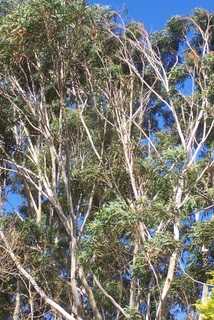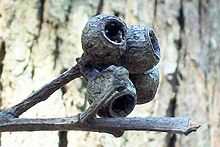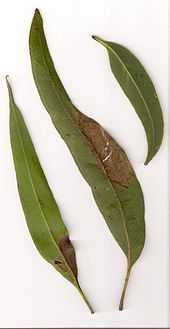Eucalyptus pilularis
| Eucalyptus pilularis | |
|---|---|
 | |
| Scientific classification | |
| Kingdom: | Plantae |
| (unranked): | Angiosperms |
| (unranked): | Eudicots |
| (unranked): | Rosids |
| Order: | Myrtales |
| Family: | Myrtaceae |
| Genus: | Eucalyptus |
| Species: | E. pilularis |
| Binomial name | |
| Eucalyptus pilularis Sm. | |
Eucalyptus pilularis, commonly known as blackbutt, is a common and dominant tree of the family Myrtaceae native to southeastern Australia. A large tree, it is identified by the stocking of rough bark, to about halfway up the trunk, above this is white smooth bark. The leaves are a uniform glossy to dark green and the white flowers occur from September to March. Blackbutt is the predominant tree species seen on the drive on the Pacific Highway between Taree and Coffs Harbour. Blackbutt is a koala food tree.[1] Economically, it is one of Australia's most important hardwoods.
Taxonomy
First described by James Edward Smith, the species name of pilularis refers to the Latin pilula (small pill or rounded knob), referring to the shape of the gumnuts.
The common name blackbutt refers to the black base of the tree after fires. The type specimen was collected from Sydney in the year 1794. First published in 1797 in Transactions of the Linnean Society by James Edward Smith.[2]
Within the genus Eucalyptus, it lies in the subgenus Eucalyptus and the section Pseudophloius, a group united by rough but not stringy bark, large opposite juvenile and glossy green adult leaves. Their leaves have adensely reticulated pattern, and the seed is red-brown, and smooth and pyramidal in shape.[3]
A taxon once described as E. pilularis var. pyriformis has been reclassified as the species E. pyrocarpa.[3]
Description
Blackbutt can grow to 50 metres in height, and a trunk diameter of 4.1 metres.[4] Though is mostly seen between 20 and 45 metres tall. Like many large eucalyptus species, the maximum height in the past is difficult to determine. Maximum heights of the blackbutt may have reached greater sizes than the largest trees still standing today. Blackbutt is a potential giant, of immense size.
Blackbutt has dark fibrous grey-brown spongy bark covering the lower part of the trunk, which comes away in strips. The bark higher up and on the branches is a glossy cream, occasionally with scribbles from insect larvae. The branchlets are square in cross section. Juvenile specimens are conspicuous, with pairs of opposite, broad-lanceolate leaves, much paler below the leaf than above which may reach 17 cm (6.8 in) long by 4 cm (1.6 in) wide.[3] Blackbutt is a Eucalyptus species without a lignotuber.[5] The adult leaves are arranged alternately on the stem, lanceolate to slightly sickle shaped, 9 to 16 cm (3.6-6.4 in) long, and 1.5 to 3 cm (0.6-1.2 in) wide. Asymmetrical at the base, they are oblique in shape. The leaves are same shade of glossy to dark green above and below the leaf. The leaf stems are four sided or squarish with a flanged edge in cross section.[3]
Flowering occurs from September to March. The inflorescences are simple on the stem, and situated at the leaf axil, and consist of 2 to 15 white flowers. Peduncles flattened 1 to 1.7 cm long. Pedicels angular 0.3 to 0.6 cm long. The club- or spindle shaped flower buds are 0.8 to 1.1 cm long and 0.4 to 0.5 cm wide. The cap of the flower bud is cone shaped or beaked.[5] The gumnuts are hemispherical or truncate globular in shape, 1.1 cm (0.4 in) by 1.1 cm (0.4 in) in size. Gumnuts similar to the related stringybark group, however with longer stems. There are four valves inside the gumnut. The disc is either flat, ascending or descending.[5] Regeneration from seed is easily accomplished.
Similar species
Blackbutt can be confused with Sydney peppermint (Eucalyptus piperita) or Sydney blue gum (E. saligna), but can be distinguished by the strong V-shape of the branch forks, which are preferred resting places for koalas.[6]


Distribution and habitat
Found in wet sclerophyll or grassy coastal forests. North from Eden on the far south coast of New South Wales up to south eastern Queensland.[5] The latitudinal range is 37.5 to 25.5 degrees south of the equator. Usually seen at low to mid altitudes, though growing at 800 metres (2500 ft) above sea level near Wauchope, where it is a dominant species. Usually seen on coastal sandy loams, but also grows well on clays and volcanic soils. Reaches large size on drier slopes near rainforest. The rainfall range is between 900 mm and 2000 mm per year. The climate for much of the distribution range is warm and humid. The mean minimum of the coldest month is around 5 to 10 degrees C, and 24 to 32 degrees C for the hottest month mean temperature. Frosts may occur in some sites away from the coast and at higher altitude.
Associated species
Blackbutt grows with a large number of other tree types. In the higher quality forests, associate species include Sydney blue gum, tallowwood, white mahogany, grey ironbark, red mahogany, coast grey box, brush box and turpentine. In drier areas it grows with trees such as spotted gum, Angophora costata, Sydney peppermint and scribbly gum.[5]
Ecology
Blackbutt forms an important element of the canopy of several endangered communities, including blue gum high forest, Illawarra lowlands, bangalay sand forest, and grassy woodland.[6]
Cultivation

On a small scale, blackbutt can be regenerated from seed by the following method: When the valves of the gumnut open, shake and tap the gumnuts until enough of the tiny seeds fall into a container. Place the seeds in a pot of sand (or other substrate). Lightly cover the seeds with sand or other potting mixture. Place the pot in a larger water filled container, such as an ice-cream container. The water will fill the inner pot with the blackbutt seeds. The seeds will then be temporarily saturated. Place the larger container with the pot of seeds into the sun (or bright light). Blackbutt seedlings should appear within a week. As sand is infertile, extra fertilizer should be added after germination.
Timber and forestry

A significant commercial species, blackbutt is well regarded by foresters for the high quality of timber, easy regeneration and quick growth. Uses include making poles, railway sleepers, flooring, building framework, cladding, joinery, lining boards, furniture, woodchipping and decking.[7] Wood density is about 900 kg per cubic metre. The sapwood is resistant to attack by lyctus borers, the heartwood is yellowish brown to light brown. Coarse textured, fairly straight grained, common small gum veins. Hard, strong, tough but not particularly difficult to work. Slow drying of mid to good levels of durability. Blackbutt timber is used in the flooring of Parliament House, Canberra.
Significant individuals
At Middle Brother National Park, there are two senescent individuals. Benaroon is 64 metres tall and 4.1 metres diameter at breast height. Bird Tree, nearby is 69 metres tall 3.59 metres diameter at breast height. An 85-metre tall blackbutt was felled near Bulli.[8] Trees over 60 metres tall are not rare in northern New South Wales.
Named in its honour
The town of Blackbutt, Queensland and the nearby Blackbutt Range are both named after the Eucalptus pilularis.[9][10]
References
- ↑ http://www.faunaaustralia.com.au/aboutus/plantation.htm
- ↑ James Edward Smith (1797). "Botanical Characters of some Plants of the Natural Order of Myrti". Transactions of the Linnean Society 3: 255–288. doi:10.1111/j.1096-3642.1797.tb00569.x.
- ↑ 3.0 3.1 3.2 3.3 Brooker MIH, Kleinig DA (1999). Field Guide to Eucalypts: Vol. 1, South-eastern Australia. Bloomings Books. p. 258. ISBN 1-876473-03-7.
- ↑ http://libero.gtcc.nsw.gov.au/Page/page.asp?Page_Id=525&h=0
- ↑ 5.0 5.1 5.2 5.3 5.4 Forest Trees of Australia, D.J. Boland et al. 1992 ISBN 0-909605-57-2 page 292
- ↑ 6.0 6.1 Leonard, Gary (2007) [1993]. Eucalypts of the Sydney Region: A Bushwalker's Guide. University of New South Wales Press. p. 20. ISBN 978-0-86840-862-0.
- ↑ http://www.timber.net.au/?option=com_species&name=Blackbutt%20&Itemid=419
- ↑ http://acms.sl.nsw.gov.au/item/itemDetailPaged.aspx?itemID=17786
- ↑ "Blackbutt (entry 2987)". Queensland Place Names. Queensland Government. Retrieved 21 December 2013.
- ↑ "Blackbutt Range (entry 2991)". Queensland Place Names. Queensland Government. Retrieved 21 December 2013.
http://plantnet.rbgsyd.nsw.gov.au/cgi-bin/NSWfl.pl?page=nswfl&lvl=sp&name=Eucalyptus~pilularis